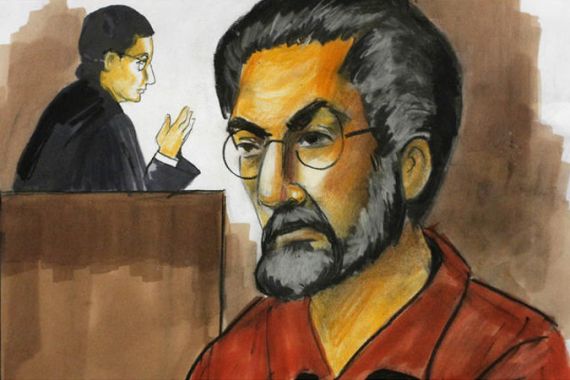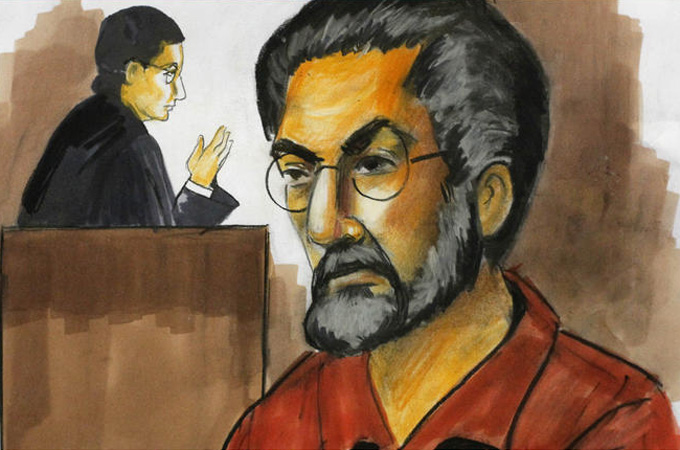Conviction in Danish cartoon attack plot
Jury finds Chicago man guilty of plotting attacks against Danish newspaper, but clears him in 2008 Mumbai rampage.

 |
|
Tahawwur Hussain Rana was convicted on Thursday of plotting an attack on a Danish newspaper [AP] |
A US federal jury has convicted a Chicago businessman of helping plot an attack against a Danish newspaper that printed cartoons of the Prophet Muhammad.
But the jury in the US state of Illinois cleared Tahawwur Rana of the most serious terrorism charge of co-operating in the deadly 2008 rampage in the Indian city of Mumbai.
The jury reached its split verdict after two days of deliberations on Thursday, finding Rana guilty of providing “material support to terrorism” in Denmark.
He was also found guilty of providing support to the Pakistan group that claimed responsible for the three-day siege in India’s largest city that left more than 160 people dead, but he was found not guilty of taking part in the attack itself.
The jurors declined to talk to the media to explain their decision, which defence attorneys described as conflicting.
Rana, a Canadian national who has lived in Chicago for years, faces up to 30 years in prison on the two charges.
“We’re extremely disappointed. We think they got it wrong,” defence attorney Patrick Blegen told reporters.
Connecting the dots
At the centre of the trial was testimony by the government’s star witness, David Coleman Headley, a longtime friend of Rana who previously pleaded guilty to laying the groundwork for the Mumbai attacks and planning to attack the Danish paper in retaliation for printing the cartoons of the Prophet Mohammed, as is prohibited in Islam. That plot was never carried out.
Headley’s testimony was closely watched worldwide because it provided a rare glimpse into the inner workings of the Pakistani group Lashkar-e-Taiba, which took credit for the Mumbai attacks, and the alleged co-operation with Pakistan’s top intelligence agency, known as the ISI.
Defence attorneys spent much of their time trying to discredit Headley, who they claimed duped his friend from a Pakistani boarding school.
They attacked Headley’s character, saying he initially lied to the FBI, lied to a judge and even lied to his own family, claiming that he implicated Rana in the plot because he wanted to make a deal with prosecutors, something he had learned after he became an informant for the US Drug Enforcement Administration after two heroin convictions.
Prosecutors, on the other hand, claimed that Rana, 50, knew exactly what he was doing when he helped Headley.
Rana, who did not testify, was on trial for allegedly allowing Headley to open a branch of his Chicago-based immigration law services business in Mumbai as a cover story while Headley conducted surveillance before the attacks in November 2008.
He was also accused of letting Headley, whose co-operation means he avoids the death penalty and extradition, travel as a representative of the company in Copenhagen.
Evidence
Prosecutors used a recorded phone call recorded between Rana and Headley on September 7, 2009, as the centrepiece of their evidence against Rana. In the call, the men discussed the Mumbai attacks and Headley talked about future targets, including the Danish newspaper Jyllands-Posten.
US Attorney Patrick Fitzgerald told reporters after the verdict that he was gratified by the jury’s decision and disagreed with defence attorneys who said the verdict was conflicting because he was convicted of supporting Lashkar-e-Taiba but acquitted of charges that he helped in the Mumbai attacks.
“There’s lots of ways you could explain it, but I haven’t spoken to the jury,” Fitzgerald said. “There was clearly evidence that he knew he was working with Lashkar.”
Six others were charged in absentia in the case, including an ISI member known only as “Major Iqbal” and Headley’s Lashkar handler Sajid Mir.
While much of Headley’s testimony had been heard before in the context of the indictment in this case and a report released by the Indian government last year, he did reveal a few new details.
Kashmiri’s ‘stronghold approach’
Among them was that another man, Ilyas Kashmiri, who US officials believed to be al-Qaeda’s military operations chief in Pakistan, had plotted to attack US defence contractor Lockheed Martin.
Kashmiri was reported killed on June 3 by a US drone attack inside Pakistan.
While US officials have not confirmed the death, Pakistani officials say they are sure Kashmiri is dead.
Headley said he worked with Kashmiri in the plot against the Danish paper, describing how the al-Qaeda leader wanted a “stronghold approach”.
One plan included taking hostages in the building and killing them quickly by beheading them.
“He said we should throw out the heads of the hostages from the windows,” Headley said of Kashmiri, speaking in a monotone and seemingly detached voice. “He said shoot them first and then behead them later, so there wouldn’t be a struggle.”